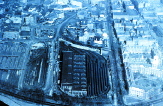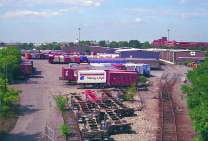Kathy Spiegelman, once an assistant city manager for Cambridge, has since 1995 been director of Harvard Planning and Real Estate, where she oversees $500 million of University-owned property. In an interview, excerpts of which follow, she discussed the major physical planning challenges that face Harvard in Cambridge and Allston.
Harvard Magazine: Why has building in Cambridge become so difficult?
Kathy Spiegelman: As the University has grown over the centuries, so has the community around us. What was originally a very small town center became an industrial city in the nineteenth century, and is now home to a culturally diverse population of almost 100,000 people. Part of the struggle we've had in comfortably allowing the growth and change in our campus that we've needed stems from the fact that, while we've been expanding, Cambridge has been maturing at a rapid rate. Traffic impacts or loss of open space--all the growth-management issues--have made people very nervous. Any time Harvard wants to build something, it potentially diminishes the quality of life.
We've tried very hard to work with the community, emphasizing that a campus needs a lot of the same quality-of-life enhancements that the community all around us needs. When we invest in open space or manage our commuter population or build housing, we are doing things in sync with the growth-management aspirations of the neighborhoods around us.
When we build bigger buildings, bring in more people, intensify the activity--that's when we have conflict. Almost all the substantial development opportunities that remain in Cambridge are at the campus edges, which typically have residential neighbors directly adjacent to what we want to do. It is much more complicated to develop institutional buildings at those edges.
Remember, from the very first buildings in the Old Yard, the University was developed to engage the external community--it wasn't an enclosed, monastic precinct. That relates to whatever we might create in Allston, as well. It makes the challenge harder, because it means giving the other side a voice at the table. But today, as you walk through the Yard gates and make the transition between commercial Harvard Square and Harvard campus, there isn't a hard edge--and that's very important because of what it has offered in terms of campus character and sense of place.
It's also important to differentiate ourselves from speculative land development. Our growth isn't based on how much we can build and the return we can get. It's linked to how well physical growth supports the academic mission: the pursuit of excellence through research and teaching and service to society. That has some societal benefits that we hope our host communities can share in and appreciate.
HM: What's been driving the growth?
KS: In the early 1990s, when Neil Rudenstine became president and the University began its capital campaign, an initial, intensive planning process articulated a shared vision for Harvard's academic future, so that the resources each program or school was trying to garner in the campaign would be woven together in support of a set of academic priorities. Those Harvard-wide priorities included improving the quality of student life, increasing faculty appointments, investing in information technology, the sciences, and the libraries, pursuing a series of international initiatives around curricular developments, and paying attention to executive education and distance learning. All of those institutional priorities inform physical planning.
In Cambridge and Allston, Harvard has grown, historically, more than one million square feet a decade. But in the 1980s and 1990s combined, Harvard grew only a million square feet. There is a pent-up demand for space, as well as demand caused by new initiatives. If you look at the five-year capital plans of the individual schools, you come up with more buildings and square footage than our land in Cambridge will support.
The Faculty of Arts and Sciences (FAS) has a large science agenda, but lacks a physical plant to support it. They have aspirations for a government and international studies center. The Law School is trying to change the way they teach and trying to allow its faculty members to have research centers as well. Their students have told them that the quality of life there needs to be enhanced. In both the Kennedy School and the international area of FAS, a lot of growth has been driven by new research centers. As for information technology, you can't take nineteenth-century buildings and assume you're going to come up to speed in information technology without renovations and, in a lot of cases, expansion. All of the institutional priorities that were articulated as part of the campaign have physical growth implications.
The notion that we will meet our growing needs with more land at the edges of our Cambridge campus is very unlikely, because we are not allowed to replace residential uses with institutional uses. That has led the University to seek a solution elsewhere--with an ambitious acquisition of land in Allston.
All those institutional objectives I identified will not be effectively supported without new buildings and major alterations to the facilities we already have, so there is a major physical-planning agenda. And we don't want to accomplish it by ruining the quality and character of what we have. So yes, Harvard Yard is fairly low density, but the University has no interest in filling in the middle of the Yard or making those buildings the equivalent of Holyoke Center. For example, our physical facilities should foster a sense of community and facilitate collegial collaboration--that's why the Freshman Union was renovated to become the Barker Center. We want to keep a pedestrian orientation for the campus, so all the planning in the Tercentenary Theatre, the Old Yard, and the North Yard [beyond Cambridge Street] has to respect that pedestrian orientation and our desire to keep the open spaces that define our campus. We want human-scale development. The challenge for us is to create a vision that protects Harvard's character but also accommodates the space needs of the University's program and mission.
HM: What's the ratio of building to open space on Harvard's campus now?
KS: The physical plant in Cambridge is 12.3 million square feet on 206 acres. Nearly 70 percent of that acreage isn't built on. It's a little misleading to call it open space, because it includes some parking lots. But we have protected open space to a much greater extent than people might think. Forty percent of the physical plant is residential--we house almost all our undergraduates and more than a third of our graduate students. One of the discussions we're having with our Cambridge neighbors is whether we can house more graduate students because of the [local] housing crisis. We have about 220 acres of land in Allston with only about 5 million square feet of building on it, so that's a statistical way of looking at why we anticipate that the University's major growth will be in Allston.
HM: Those recently acquired buildings aren't particularly well adapted to academic purposes at this point, are they?
KS: That includes the Business School campus and the athletic facilities, but most of the other buildings on the Allston land don't have academic uses. The sites are likely to be redeveloped for institutional use.
HM: How do you plan for the use of the Allston acreage?
KS: Development options within our present campus are limited because Harvard is organized as a series of academic precincts. The School of Education, for instance, might want to add some classroom or faculty office space; the fact that we might have a site up in the North Yard doesn't help them because it isn't functionally possible for them to add to their programs by using a site way over on the other side of somebody else's precinct.
The other complication for somebody like me--trying to represent the collective interests across the University--is that each academic unit has its own financial resources and its own academic and physical planning processes. But the fact that we're running out of room motivates people to think more collectively. We believe this is a real opportunity for people to come together and solve problems in a better way.
HM: Where is the expansion now?

The MBTA carbarns once stood on what is now the site of the John F. Kennedy Park and Harvard's Kennedy School of Government.

Kathy Spiegelman, director of Harvard Planning and Real Estate, says the reclamation of that land is analogous to what the University plans for the former Massachusetts Turnpike Authority property, now similarly encumbered with easements and transportation uses.
KS: There are a lot of significant projects going on, so as we think about a future in Allston, we can't lose sight of the fact that a lot of the program initiatives funded by the campaign can't wait for us to go through the community master-planning process for the Allston property.
Executive education and distance learning programs at the Division of Continuing Education required us to apply for an addition to and renovation of a building on Church Street. The Kennedy School of Government's new faculty appointments and new centers have required the rental of office space in the Square. The school is preparing to try to build an addition to its campus in the next five years. The center for government and international studies has been wending its way through the community-approval process for more than three years--that's evidence of what it means to do a significant development project at the edge of our Cambridge campus. The Widener Library renovation and the Divinity School's construction at Andover Library are examples of how the library initiative influences physical-planning goals. Several schools are embarked on projects for classroom renovation or student centers. There is a life-sciences building under construction in FAS, and an architect has been selected for a physical-sciences building.
The North Yard is the largest, most significant potential redevelopment area in Cambridge. FAS is engaged in significant planning for that area, trying to think about buildings that could be reconfigured or rearranged or new buildings that could be developed, because they plan to add to their scientific research capacity [see "Elbow Room," page 61]. At the same time the Law School, which has decided that it would like to grow without having to leave Cambridge, has aspirations to add square footage at the same edge--not necessarily on the same sites, but clearly at the same edge in terms of a political strategy for talking to our neighbors about what might happen there.
HM: How does that dialogue work?
KS: We've had an interesting approach there. Before a project was articulated, we talked to our neighbors about a transition edge, voluntarily down-zoning ourselves there in hopes that it would allow more flexibility as we moved back into the site. [See "Good Zoning Makes Good Neighbors," November-December 1999, page 84.] In the midst of that, we ended up--as a result of reconfiguring the government and international studies center--having to find a new site for University Information Services in the northernmost corner of the North Yard. So suddenly we had another project that had to fit the guidelines we had negotiated with our neighbors. Interestingly enough, our common understanding of guidelines with our neighbors has allowed some flexibility and freedom for that design that we'd like to see replicated in other places where we're working. But Cambridge remains a complex regulatory environment.
We don't want to spend three or four years getting approval for each building project, so we benefit from the establishment of campus-edge parameters before we present specific building proposals. As we look across to Allston, our expectation is that the task force we've been working with there, and now a broader group that's working on community master planning, will be another forum for a dialogue about a future campus, in advance of our proposing actual projects and uses, so we won't run into disagreements about objectives.
When we look at the schools' capital plans and all the projects and academic objectives, what isn't clear is the plan for infrastructure, and especially housing. The last new housing project we did was the DeWolfe Street development, more than 10 years ago. With sites so scarce in Cambridge and the existing academic core buildings so strategic to academic activities, the most likely place for expanding our housing resources is in Allston. There are some sites in Cambridge and surrounding communities that we're looking at as well. But I think the University has a responsibility in the near-term to articulate a set of goals for housing. That can't be done school by school--it has to be done by bringing the schools together.
HM: What does Harvard offer, besides a good mix of buildings and open space?
KS: The University makes tremendous cultural contributions to our host communities. Obviously, because the museums are currently located in Cambridge, the evidence of that contribution is much more clear there, but we're searching for opportunities to do the same in Allston. And in fact there is an ongoing discussion with all of the museums in Cambridge about whether there is an appropriate match between their needs and potential development sites in Allston [see "Another Museum Proposed," page 55].
As for commercial character, it would be wonderful to think about how we might bring some of the vibrancy of Harvard Square--to which Harvard contributes--to commercial and service activities in Allston. A lot of the buildings Harvard owns in the Square have commercial tenants who serve the student and employee base at Harvard as well as the larger Cambridge and tourist community. We have had an interest in keeping some of those tenants even if it means charging below-market rents. So the interest of groups like the Harvard Square Defense Fund--making sure the Square is not just a place for chains--has been possible because of Harvard's attitude toward our commercial properties in the Square.
But we're going to have to solve some very significant transportation issues before our aspirations in Allston can come to fruition. The fact that you can only get from here to there across the Larz Anderson Bridge, or the Weeks Bridge for pedestrians--and the fact that right now you can't get off the turnpike into the land we now own--suggests that we can't have a new campus or a mixture of uses until we figure out what kind of transportation infrastructure we need.
HM: Is there a precedent for the kind of redevelopment that Harvard will have to undertake in Allston?
KS: Yes. Even though a lot of the academic planning processes in the different schools still overlook the property in Allston, there is a whole series of historical examples of the University acquiring property that seemed unattractive for in- stitutional uses, or felt too distant, but subsequently became an integral part of the campus. Take the River Houses on the Charles or the MBTA carbarn in the southwest sector of Harvard Square that was originally identified as a site for the Kennedy Library. When the library was relocated, the University became a major participant in redeveloping the area, and part of the site became the Kennedy School of Government and the John F. Kennedy Park.
The University was able to transform through open space and academic uses an area that otherwise had been industrial and made no contribution to the recreational and environmental quality of the river. So the long-term goal is not literally to drop the physical configuration of Harvard Yard into the rail yards and associated properties that we own in Allston, but to take the design elements that shape our Cambridge campus conceptually and apply them to Allston.
HM: Harvard has reportedly hired an architect to develop a plan for the University's growth in Allston. Has that work begun? How do you plan to use his work?
KS: The University's physical planning committee, which Harvard Planning and Real Estate staffs, took this opportunity to hire Rem Koolhaas [professor in the practice of architecture and urban design at the Graduate School of Design] to help us create a vision: what are the place-making elements that might guide our more specific programmatic decisions in Allston about how institutional uses can mix with commercial and residential uses to create the kind of campus environment that Harvard has been able to thrive in for almost 400 years. His work should be presented to the physical planning committee this spring, so it will be available to inform a new president and the members of the Corporation so they can help work with the deans on decisions about using the Allston land resources.
HM: Is there an effective way to coordinate Harvard's planning processes now?
KS: No. And I really think that has got to be on the new president's agenda, because we know from looking at the current capital plans that everybody can't do all the projects on their wish lists without a clear University decision-making process that sets priorities, arbitrates conflicts, and sets a vision for the shared campus.









